Yamaha NS-P160 User Manual [ru]

G
Speaker Package
Package Enceintes
NS-PA160 / NS-P160
(NS-C160 + NS-B160)
English
Français
Deutsch
Español
Русский
Owner’s Manual Mode d’emploi Bedienungsanleitung Manual De Instrucciones
Инструкция По Эксплуатации
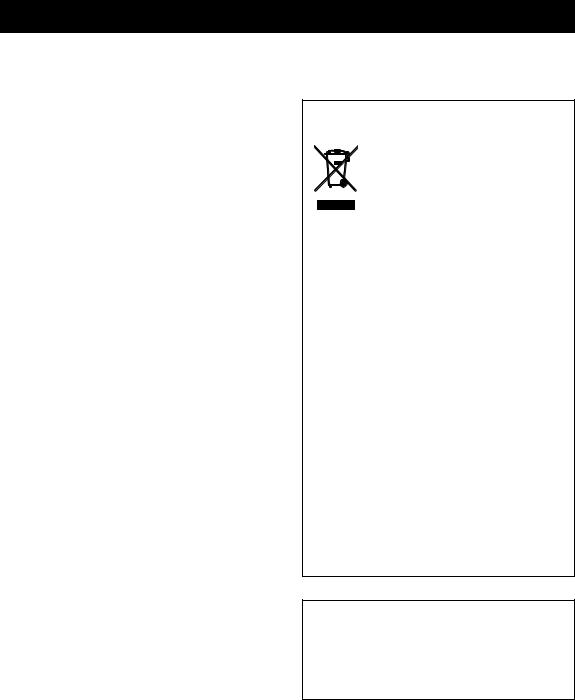
Precautions
Please read the following operating precautions before use. Yamaha will not be held responsible for any damage and/or injury caused by not following the cautions below.
1.To assure the finest performance, please read this manual carefully. Keep it in a safe place for future reference.
2.Install the speakers in a cool, dry, clean place – away from windows, sources of heat, sources of excessive vibration, dust, moisture or cold. Avoid sources of electrical humming (e.g., transformers and motors). To prevent fire or electric shock, do not expose the speakers to rain or water.
3.To prevent the enclosure from warping or discoloring, do not expose the speakers to direct sunlight or excessive humidity.
4.Avoid installing the speakers where foreign objects may fall onto them and/or where they may be exposed to liquid dripping or splashing.
5.Do not place the following objects on top of the speakers:
–Other components, as they might damage or discolor the surface of the speakers.
–Burning objects (e.g., candles), as they might cause fire, damage to the speakers or personal injury.
–Containers of liquid, as they might spill and cause electric shock to the user or damage to the speakers.
6.Do not place the speakers where they are liable to be knocked over or struck by falling objects. Stable placement will also ensure better sound performance.
7.Placing the speakers on the same shelf or rack as the turntable can result in feedback.
8.Any time you note distortion, reduce the volume control on your amplifier to lower setting. Never allow your amplifier to be driven into “clipping”. Otherwise, the speakers may be damaged.
9.When using an amplifier with a rated output power higher than the nominal input power of the speakers, care should be taken not to exceed the maximum input of the speakers.
10.Do not attempt to clean the speakers with chemical solvents as this might damage the finish. Use a clean, dry cloth.
11.Do not attempt to modify or fix the speakers. Contact qualified Yamaha service personnel when service is needed. The cabinet should never be opened for any reason.
12.Secure placement or installation is the owner’s responsibility. Yamaha is not liable for accidents caused by improper placement or installation of speakers.
Information for Users on Collection and Disposal of Old Equipment
This symbol on the products, packaging, and/or accompanying documents means that used electrical and electronic products should not be mixed with general household waste.
For proper treatment, recovery and recycling of old products, please take them to applicable collection points, in accordance with your national legislation and the Directives 2002/96/EC.
By disposing of these products correctly, you will help to save valuable resources and prevent any potential negative effects on human health and the environment which could otherwise arise from inappropriate waste handling.
For more information about collection and recycling of old products, please contact your local municipality, your waste disposal service or the point of sale where you purchased the items.
[Information on Disposal in other Countries outside the European Union]
This symbol is only valid in the European Union. If you wish to discard these items, please contact your local authorities or dealer and ask for the correct method of disposal.
Taking care of the speaker
When you wipe this unit, do not use chemical solvents (e.g., alcohol or thinners, etc.): this might damage the finish. Use a clean, dry cloth. For difficult soils, dampen a soft cloth in water, wring it out, and then wipe with the cloth.
i En
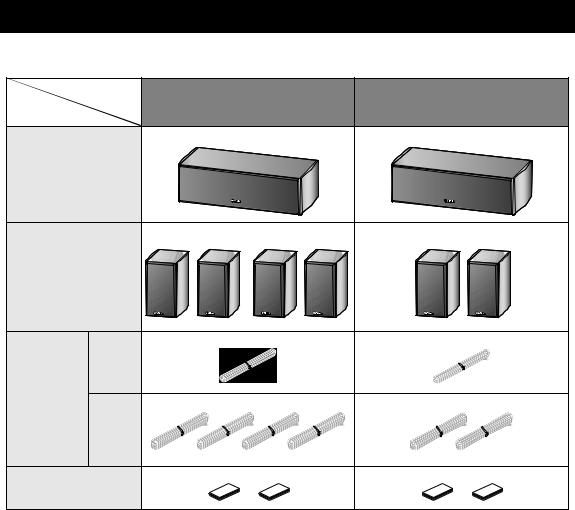
|
Contents |
|
|
|
|
Package contents................................................ |
1 |
Connecting the speakers .................................. |
4 |
|
|
Installing the speakers |
2 |
Connection diagram |
4 |
|
|
|
|||||
Installing the center speaker................................ |
2 |
Specifications...................................................... |
5 |
|
English |
Wall-mounting the speakers |
3 |
|
|
|
|
|
|
|
|
||
|
|
|
|
|
|
|
|
|
|
|
|
Package contents
Make sure the package contains the following items.
Type of package |
|
NS-PA160 |
NS-P160 |
Contents |
|
Center speaker |
|
(NS-C160) |
|
Surround speaker |
|
(NS-B160) |
|
4 m |
|
(13.1 ft.) |
|
Speaker cable |
|
10 m |
|
(32.8 ft.) |
|
Fastener |
|
(for center speaker) |
|
1 En
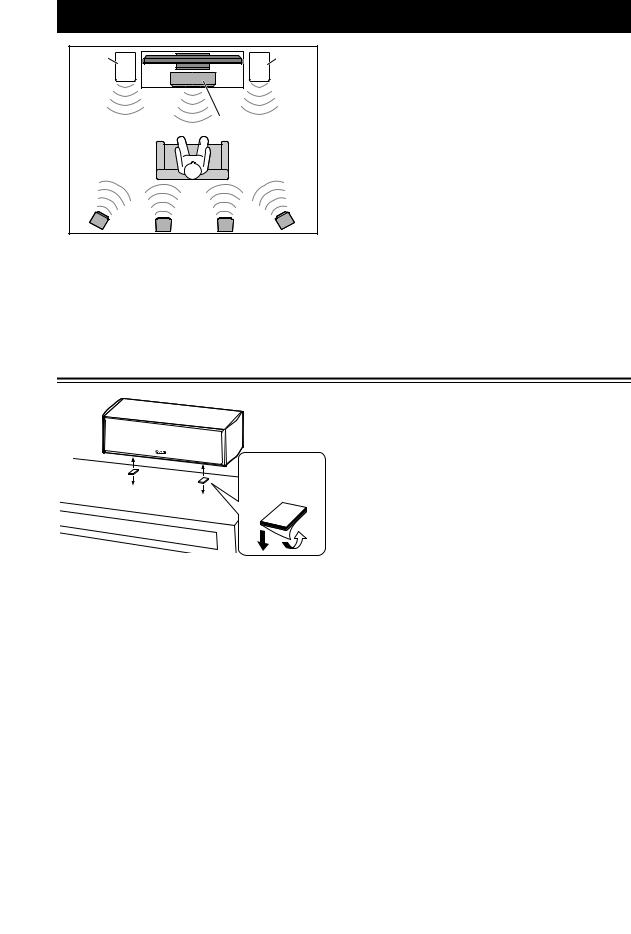
Installing the speakers
* Front |
* Front |
left |
right |
|
Center |
|
NS-C160 |
** Surround left |
Surround back |
** Surround right |
NS-B160 |
NS-B160 |
NS-B160 |
|
(NS-PA160 only) |
|
Before you connect the speakers, place each speaker in its respective location. Speaker positioning is very important as it affects the overall sound quality of the system. Place the speakers in locations that will optimize the sound quality at your listening position. Refer to the illustration.
Note
•Placing the speakers too close to a CRT-type TV may impair the picture color or cause a buzzing noise. In this case, move the speakers at least 20 cm (8") away from the TV. This is not an issue with LCD and plasma TVs.
* Place the two front speakers (commercially available) on the left and right sides of the TV, facing directly forward. ** Place the left and right surround speakers behind your listening position, facing slightly inward.
Installing the center speaker
Fastener
Peel off the seal.
TV rack, etc.
Place the center speaker centrally between the front speakers, facing directly forward.
When placing it on a flat surface (TV rack, etc), affix the supplied fasteners to bottom of the speaker. Refer to the illustration.
When wall-mounting it, see “Wall-mounting the speakers” (page 3).
Note
•Wipe the surface clean before affixing the fasteners. If the surface is dirty, oily or wet, adhesive strength is weakened and the speaker may fall.
2 En

Installing the speakers
Wall-mounting the speakers
You can mount the speakers on the wall as follows.
Wall/ |
26 mm (1") |
NS-B160 |
1.8 kg |
||
wall support |
|
(4.0 lbs.) |
 3 mm (1/8")
3 mm (1/8")
Minimum 20 mm (3/4")
NS-C160 210 mm (8-1/4") 2.9 kg
(6.4 lbs.)
1Install screws into a solid wall or wall support as shown in the illustration. Use 3.5 to 4 mm (1/8") diameter self-tapping screws.
2Hang each speaker by its keyhole slots onto the protruding screws.
Note
•Make sure the shaft of the screw is seated in the narrow part of the keyhole slot. Otherwise, the speaker may fall.
Warnings
•Do not mount the speakers on thin plywood or on a wall with a soft surface material. Otherwise, the screws may pull out of the surface and the speakers may fall, possibly damaging the speakers or causing personal injury.
•Do not affix the speakers to a wall using nails, adhesives, or unstable hardware. Long-term use and vibration may cause the speakers to fall.
•To avoid accidents resulting from tripping over loose speaker cables, affix the cables to the wall.
•Mount the speakers in a wall location that will be unlikely to result in injury to an individual’s head.
•When using speaker brackets (commercially available) to mount the speakers on the wall or ceiling, we strongly recommend using safety wire (may be supplied with the bracket) between the speaker and bracket to prevent the speaker from falling.
•When installing these speakers on a wall mounted bracket, it is essential that they are firmly secured. Be sure to consult a reliable source about the best type of fastener for your particular wall/ceiling’s construction.
■ Mounting the center speaker on the Yamaha YTS-F500/YTS-T500 TV stand
You can use the screw holes [diameter: 6 mm (1/4"), hole depth: 16 mm (5/8")] on the rear of this unit to mount the speaker on the YTS-F500/YTS-T500. For installation details, please refer to the owner’s manual that came with the YTS-F500/YTS-T500.
NS-C160 Rear view
95 mm (3-3/4")
290 mm (11-1/2")
Insert screws “D (M6 x 16)” that came with the YTS-F500/YTS-T500 into the screw holes.
Use speaker bracket “B” that came with the YTS-F500/YTS-T500.
NS-C160 |
(Installation example |
|
using YTS-F500) |
Notes
•Be careful not to pinch the speaker cables between the speaker and the speaker bracket or speaker stand.
•Do not lean or place any object on the speaker. Otherwise, the TV stand bracket may be deformed.
English
3 En
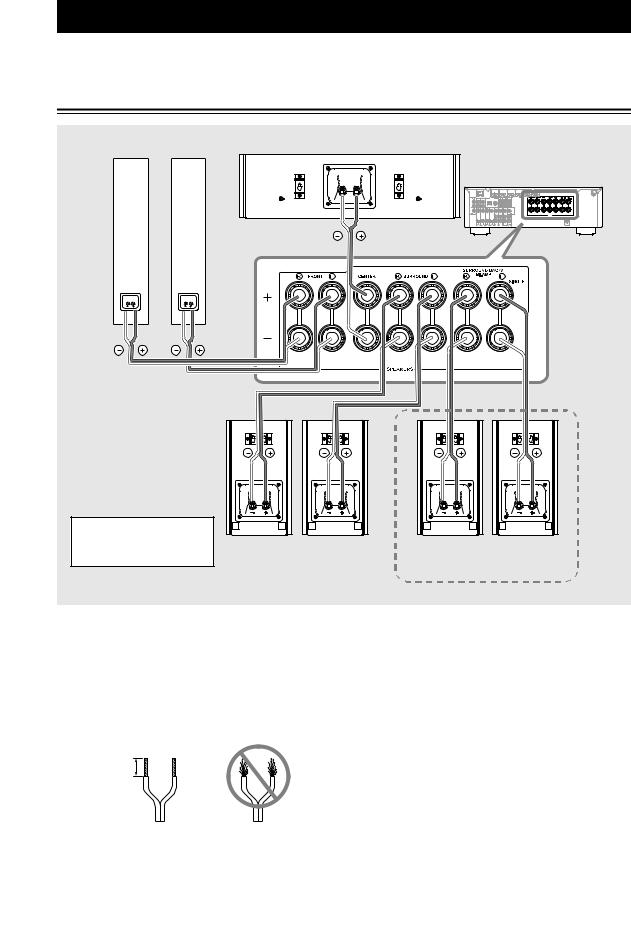
Connecting the speakers
Caution: Make sure the power cables for your other AV components are disconnected from the AC wall outlets before making any connections.
Connection diagram
Front speakers |
Center speaker |
||
Right |
Left |
||
|
|||
Amplifier
Note: The exact layout of |
|
|
|
|
the speaker terminals |
Right |
Left |
Right |
Left |
depends on your amplifier. |
Surround speakers |
Surround back speakers |
||
|
||||
(NS-PA160 only)
■ Preparing the speaker cables
Once you’ve positioned the speakers, you’ll need to prepare the speaker cables for connecting the speakers.
1Remove about 15 mm (5/8") of insulation from the end of each speaker cable.
2 Twist the bare wires tightly.
15 mm (5/8")
Notes
•Do not bundle or roll up excess cable.
•Twist the bare wires tightly so the individual strands are not splayed.
•Be careful not to injure yourself while preparing the speaker cables.
Good |
No Good |
4 En
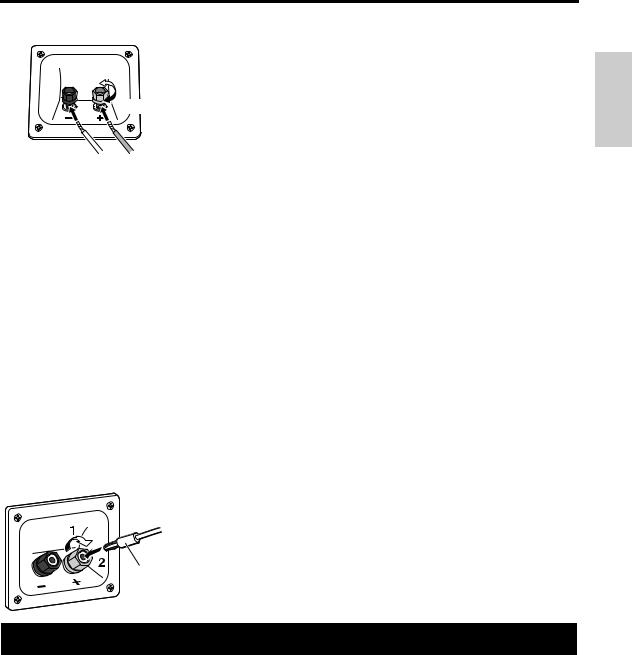
|
|
|
Specifications |
■ Operating the speaker terminals |
|
||
|
|
1 |
Rotate the speaker terminal counterclockwise to loosen it. |
Loosen |
|
2 Insert the bare wire. |
|
|
Tighten |
3 |
Rotate the speaker terminal clockwise to tighten it. |
|
4 |
|
|
|
|
Test the security of the connection by pulling gently on the |
|
Negative (–) |
Positive (+) |
|
cable. |
|
|
||
Notes
•Make sure the terminal is gripping the bare wire, not the insulation.
•Make sure the bare wires do not touch each other, as this could damage the speaker or amplifier.
•If the connections are faulty, you will hear no sound from the speakers.
■ Connecting to an amplifier
Connect each speaker to the appropriate speaker terminals on your amplifier by using the cables you prepared earlier. For details, see the “Connection diagram” (page 4).
For the surround and surround back speakers only, connect one speaker to the left (marked L) terminals of your amplifier or receiver, and another speaker to the right (marked R) terminals.
Please refer to the owner’s manual that came with your amplifier or receiver.
Notes
•Make sure you connect the speakers with the correct polarity—positive (+) terminals to positive (+) terminals, and negative (–) terminals to negative (–) terminals. If you get them crossed over, the sound will be unnatural and lack bass.
•In your AV receiver’s speaker size settings, specify small (or “S”) for all of the speakers.
•The speaker may be damaged if certain sounds are continuously output at high volume level. For example, if sine waves from a test disc, bass sounds from electronic instruments, etc., are continuously output, or when the stylus of a turntable touches the surface of a disc, reduce the volume level to prevent the speaker from being damaged.
•Once you have connected all of the speakers, plug the amplifier and other AV components into suitable AC wall outlets.
•When using an amplifier with a rated output power higher than the nominal input power of the speaker, care should be taken never to exceed the speaker’s maximum input.
■ When using a banana plug
1 Tighten the terminal knob.
2 Simply insert the banana plug into the terminal.
Banana plug
Specifications
■ Center speaker (NS-C160) |
■ Surround speakers (NS-B160) |
||
Type.................................................. |
2-way acoustic suspension |
Type.................................................. |
2-way acoustic suspension |
|
Non-magnetic shielding type |
|
Non-magnetic shielding type |
Driver Woofer............................. |
8 cm (3-1/4") cone type x 2 |
Driver Woofer.................................... |
8 cm (3-1/4") cone type |
Tweeter ................. |
1.4 cm (1/2") balanced dome type |
Tweeter ................. |
1.4 cm (1/2") balanced dome type |
Nominal input power ....................................................... |
30 W |
Nominal input power ....................................................... |
20 W |
Maximum input power .................................................... |
80 W |
Maximum input power .................................................... |
60 W |
Impedance ............................................................. |
Nominal 6 Ω |
Impedance ............................................................. |
Nominal 6 Ω |
Frequency response ......................... |
60 Hz - 38 kHz (–10 dB) |
Frequency response ......................... |
60 Hz - 38 kHz (–10 dB) |
|
- 100 kHz (–30 dB) |
|
- 100 kHz (–30 dB) |
Sensitivity ...................................................... |
86 dB/2.83 V, 1 m |
Sensitivity ...................................................... |
82 dB/2.83 V, 1 m |
Dimensions (W x H x D) ........................ |
465 x 135 x 172 mm |
Dimensions (W x H x D) ........................ |
150 x 265 x 152 mm |
|
(18-1/4" x 5-3/8" x 6-3/4") |
|
(5-7/8" x 10-3/8" x 6") |
Weight ................................................................. |
2.9 kg (6.4 lbs) |
Weight ................................................................. |
1.8 kg (4.0 lbs) |
Specifications are subject to change without notice.
English
5 En

Précautions
Lisez attentivement les précautions d’utilisation suivantes. Yamaha décline toute responsabilité en cas de dommages et/ou de blessures découlant du non respect de ces consignes.
1.Pour profiter au mieux de votre acquisition, lisez attentivement ce mode d’emploi. Conservez-le soigneusement pour référence.
2.Installez les enceintes dans un endroit frais, sec, loin des fenêtres et des sources de chaleur et de vibration, des poussières, de l’humidité et du froid. Évitez les sources de ronflements électriques (transformateurs et moteurs, par exemple). Pour éviter les risques d’incendie et de secousses électriques, n’exposez pas les enceintes à la pluie ni à l’humidité.
3.Pour éviter que la menuiserie des enceintes ne se déforme ou ne se décolore, n’exposez pas les enceintes
àla lumière directe du soleil ni à une humidité excessive.
4.Évitez d’installer les enceintes dans un endroit exposé à la chute d’objets ou encore à l’écoulement ou aux éclaboussures de liquides.
5.Ne posez pas les objets suivants sur le dessus des enceintes:
–D’autres appareils qui pourraient endommager ou décolorer la menuiserie des enceintes;
–Des objets enflammés (par exemple, des bougies) qui pourraient endommager les enceintes, provoquer une blessure, voire un incendie;
–Des récipients contenant des liquides qui pourraient se renverser, endommager les enceintes ou être à l’origine d’une secousse électrique.
6.Ne placez pas les enceintes dans un endroit où elles peuvent être heurtées, directement ou par la chute d’objets. Un emplacement stable garantit l’obtention de meilleures sonorités.
7.Placer les enceintes sur des étagères ou dans un meuble qui contient également la platine de lecture, peut entraîner un phénomène de bouclage.
8.En cas de “saturation”, réduisez le niveau de sortie de l’amplificateur. N’excitez pas l’amplificateur au point qu’il écrête. Dans ce cas en effet, les enceintes pourraient être endommagées.
9.Vous devez être très attentif, si l’amplificateur peut délivrer une puissance supérieure à la puissance maximale admissible par les enceintes, à ce que cela ne se produise pas.
10.Ne nettoyez pas la menuiserie des enceintes avec un produit chimique qui peut endommager leur finition. Utilisez un chiffon sec et propre.
11.Ne tentez pas de modifier les enceintes ni de les réparer. Consultez le service Yamaha compétent si une réparation est nécessaire. Pour quelque raison que ce soit, ne démontez pas la menuiserie des enceintes.
12.La détermination d’un endroit convenable est de votre responsabilité. Yamaha ne saurait être responsable des accidents provoqués par le choix d’un emplacement qui ne conviendrait pas, ni par l’installation incorrecte des enceintes.
Information concernant la Collecte et le Traitement des déchets d’équipements électriques et électroniques
Le symbole sur les produits, l’emballage et/ou les documents joints signifie que les produits électriques ou électroniques usagés ne doivent pas être mélangés avec les déchets domestiques habituels.
Pour un traitement, une récupération et un recyclage appropriés des déchets d’équipements électriques et électroniques, veuillez les déposer aux points de collecte prévus à cet effet, conformément à la réglementation nationale et aux Directives 2002/96/EC.
En vous débarrassant correctement des déchets d’équipements électriques et électroniques, vous contribuerez à la sauvegarde de précieuses ressources et à la prévention de potentiels effets négatifs sur la santé humaine qui pourraient advenir lors d’un traitement inapproprié des déchets.
Pour plus d’informations à propos de la collecte et du recyclage des déchets d’équipements électriques et électroniques, veuillez contacter votre municipalité, votre service de traitement des déchets ou le point de vente où vous avez acheté les produits.
[Information sur le traitement dans d’autres pays en dehors de l’Union Européenne]
Ce symbole est seulement valables dans l’Union Européenne. Si vous souhaitez vous débarrasser de déchets d’équipements électriques et électroniques, veuillez contacter les autorités locales ou votre fournisseur et demander la méthode de traitement appropriée.
Entretien de l’enceinte
Lorsque vous essuyez cet appareil, n’utilisez pas de solvant chimique (l’alcool ou des diluants etc.) : cela pourrait endommager la finition. Utilisez un chiffon propre et sec. Pour les taches difficiles, humectez un chiffon doux avec de l’eau, essorez et puis essuyez avec le chiffon.
i Fr
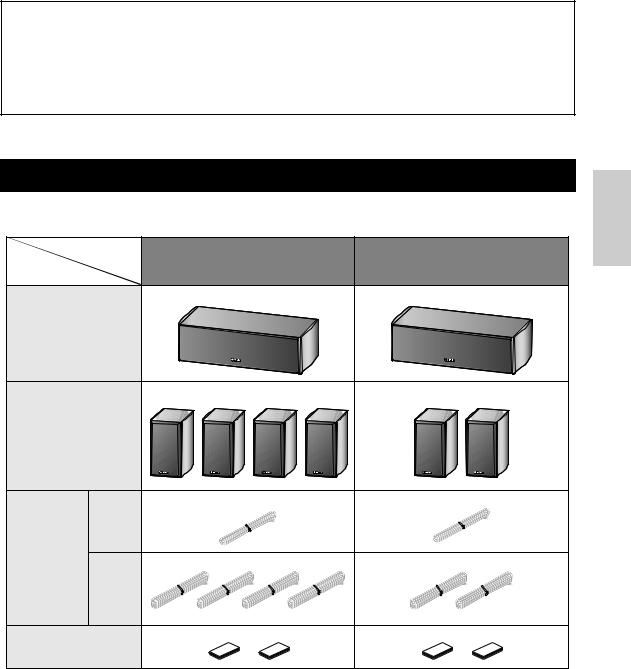
Sommaire
Contenu de l’emballage..................................... |
1 |
Connexion des enceintes.................................. |
4 |
Installation des enceintes ................................. |
2 |
Diagramme de raccordement.............................. |
4 |
Installation de l’enceinte centrale ........................ |
2 |
Caractéristiques techniques............................. |
5 |
Monter les enceintes sur le mur .......................... |
3 |
|
|
Contenu de l’emballage
Veuillez-vous assurer que l’emballage contient les éléments suivants. |
Français |
||
Type |
|
||
NS-PA160 |
NS-P160 |
||
d’enceinte |
|||
Contenu |
|
|
|
Enceinte Centrale |
|
|
|
(NS-C160) |
|
|
|
Enceinte Surround |
|
|
|
(NS-B160) |
|
|
|
4 m |
|
|
|
Câble |
|
|
|
d’enceinte |
|
|
|
10 m |
|
|
|
Patins antidérapants |
|
|
|
(Pour enceinte centrale) |
|
|
|
1 Fr
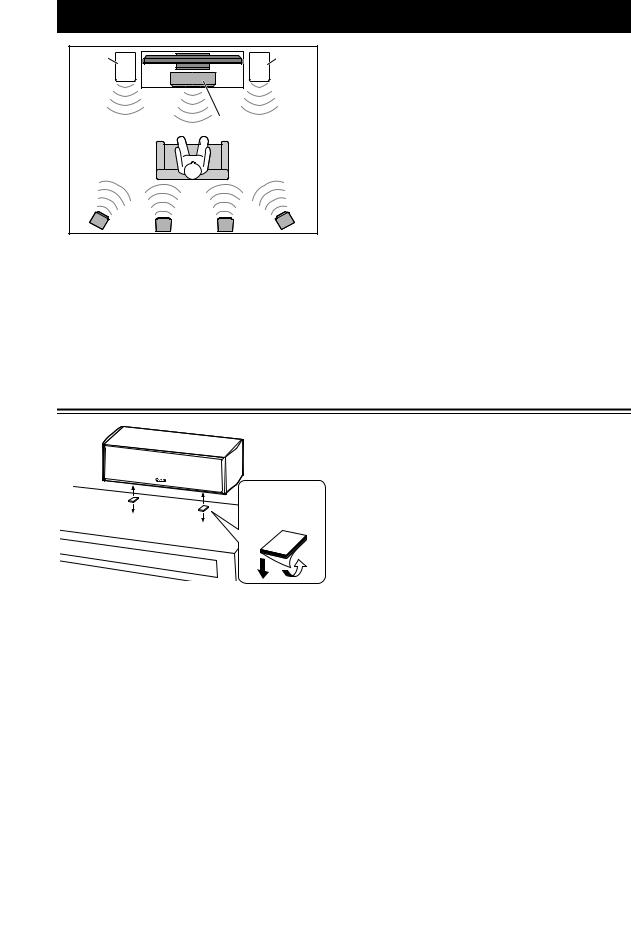
Installation des enceintes
* Avant |
|
* Avant |
gauche |
|
droit |
|
Centre |
|
|
NS-C160 |
|
** Surround |
Surround arrière |
** Surround |
gauche |
NS-B160 |
droite |
NS-B160 |
(NS-PA160 seulement) |
NS-B160 |
Avant de connecter les enceintes, placez chaque enceinte dans sa position respective.
Le positionnement de l’enceinte est très important car il affecte toute la qualité sonore du système. Placez les enceintes dans des positions qui optimiseront la qualité sonore dans votre position d’écoute. Référezvous à l’illustration.
Remarque
•Placez ce haut-parleur trop près d’un téléviseur CRT pourrait affaiblir la couleur de l’image et créer un bruit de bourdonnement. Dans ce cas, éloignez les enceintes d’au moins 20 cm du téléviseur. Ce n’est pas un problème que vous rencontrerez avec les téléviseurs plasma et LCD.
*Placez les deux enceintes avant (disponibles sur le marché) à la gauche et à la droite du téléviseur, orientez-les vers l’avant.
**Placez les enceintes surround droite et gauche derrière votre position d’écoute, orientées les légèrement vers l’intérieur.
Installation de l’enceinte centrale
Patins antiderapants
Retirez l’étiquette de protection.
Un meuble de téléviseur, etc.
Placez l’enceinte centrale exactement au milieu des enceintes avant, orientée directement vers l’avant.
Quand vous les placez sur une surface plane (ou sur un meuble de téléviseur, etc.), attachez les patins antidérapants fournis sous l’enceinte. Référez-vous à l’illustration.
Quand vous le montez sur le mur, voir “Monter les enceintes sur le mur” (page 3).
Remarque
•Nettoyez la surface avant d’y attacher les fixations. Veuillez noter que le pouvoir adhésif est considérablement réduit si cette surface est sale, grasse ou humide, cela pourrait entraîner la chute de l’enceinte.
2 Fr
